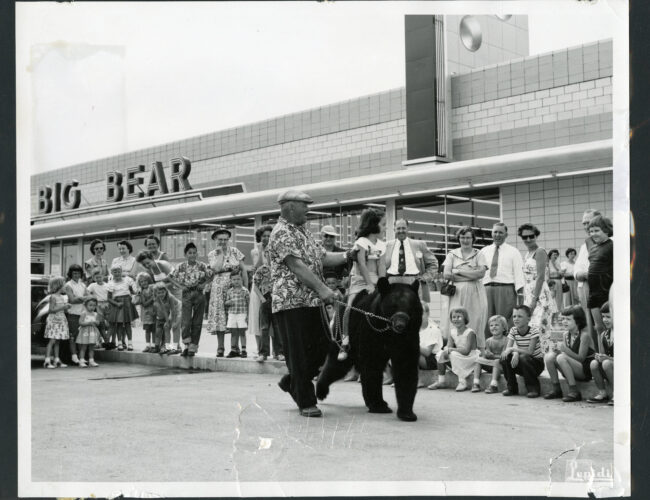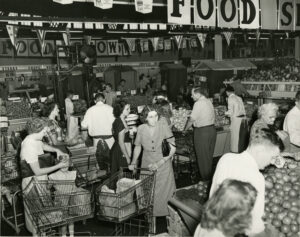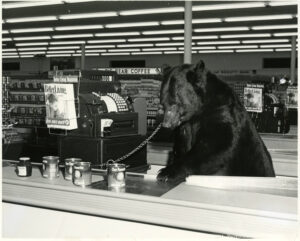Big Bear: The Original Columbus Supermarket

“Quality low priced foods. The one complete, one stop super food market.” Slogans like this are commonplace, but there was a time when promises such as these were met with skepticism. This is the story of Wayne E. Brown and the founding of the first self-service supermarket in the Midwest: Big Bear.
Wayne E. Brown grew up in Coalton, Ohio. After graduating high school, Brown began his career in the grocery business weighing potatoes. Ambitious and hardworking, Brown advanced from Clerk to General Superintendent. His business travels took him to many Ohio cities, during which he got to know and love Columbus.

Before supermarkets became common, goods were located on shelves behind the counter and retrieved by a store clerk upon request. Brown’s many years of knowledge and experience sparked the idea of a self-service supermarket. Customers could browse at their leisure, bring their selected items to the front of the store, and pay for them before leaving. This model would save the consumer time and money by shopping less frequently and buying more goods at one time. This idea was met with disapproval from corporate leaders, who feared that the customers would ‘steal them blind.’ Brown disagreed and decided to open his own store in the capital city.
In 1934, the first Big Bear location was established in a failed roller-skating rink at 386 W. Lane Avenue. This was the only building large enough to try the new idea of stacking cartloads of merchandise out on the floor. More than 200,000 people visited the store, in its first three days, and they were amazed by the large variety of inventory and low prices.

The name Big Bear was selected because it was catchy and something children would remember. Maybe more memorable was the trained bear, that customers could see, at the entrance of the store. This bear was at the store for several years and would do tricks for anyone who wanted to stop and watch. Eventually the bear was donated to the Columbus Zoo.
From that first store in 1934, Brown built the business into a chain that operated 65 supermarkets, discount department stores, and pharmacies in Ohio, West Virginia, and Kentucky. Big Bear was the first to introduce Raymond Loewy’s concept of store layout, with perishable departments in the center of the store, low fixtures, and pleasing décor. This layout quickly became the industry standard. Big Bear’s other firsts include merchandising gimmicks, warehousing innovations, air curtain doors, motorized counters, complete non-food departments, guarantee of purchase (or your money back), and free parking. This business model became so popular that it too became the industry standard.

Wayne E. Brown died in August 1976, at which time Big Bear Stores was sold to Oppenheimer & Co., a New York diversified investment company. Memories shared in Brown’s obituary, and subsequent newspaper articles, paint pictures of his kindness and generosity. There are stories of Brown delivering fresh food to customers on Thanksgiving Day, paying off a family’s mortgage, investing in small local business owners, and sponsoring a young Jack Nicklaus’ PGA Tour.
The supermarket chain continued to thrive until the company announced their bankruptcy, in May 2003. By 2004, the 70-year-old company was gone altogether. Big Bear may be gone, however, Wayne E. Brown’s impact on the modern supermarket can still be seen in shopping aisles today.
Thank you to Aimee Truitt, Catalog & Metadata Coordinator at the Ohio History Connection, for this week’s post!



Leave a Reply
You must be logged in to post a comment.